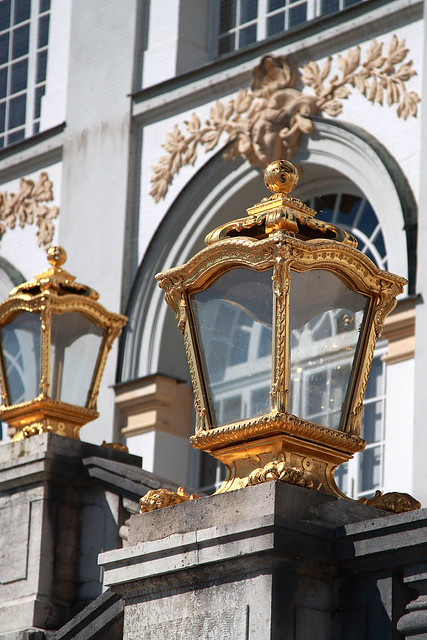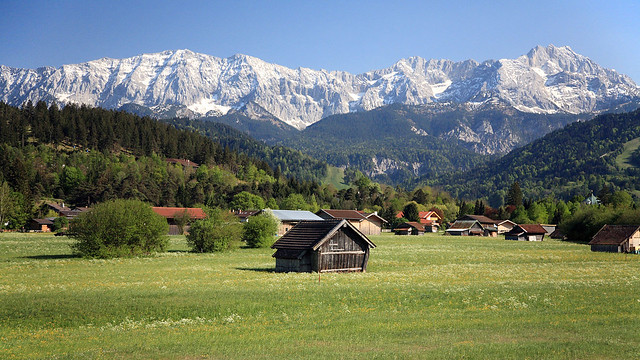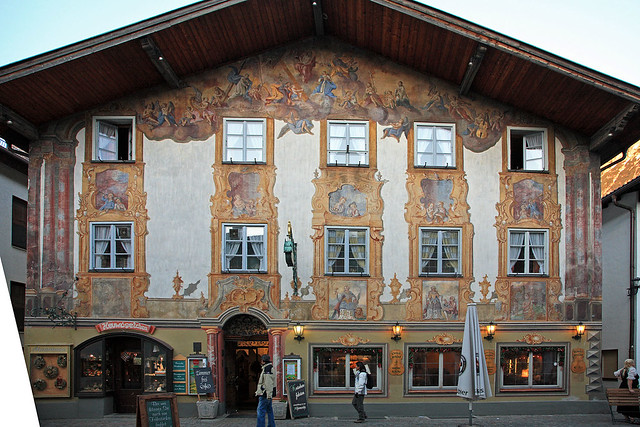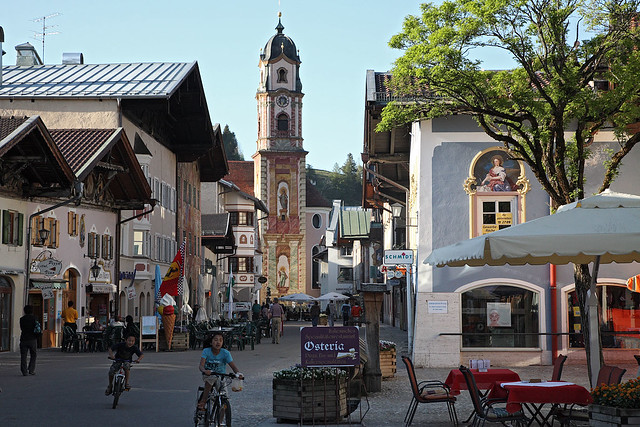
Schloss Nymphenburg
[ < < previous | index | next >> ]
We slept in until 07:30 this morning and had a lazy breakfast before checking out and using the morning to travel over to Schloss Nymphenburg. Michelle tried two types of Nutella-oid spread this morning, one with the usual hazelnuts and one with almonds that I liked better from a sample taste.
We just said auf wiedersehen to Munich and are on our way south to the Alps. This morning we walked over to the Hauptbahnhof and bought a group day pass good for up to five people to ride the public transport all day. We boarded a number 17 tram at Hauptbahnhof Nord and it took us west then north to Schloss Nymphenburg.
 Schloss Nymphenburg |
The tram stop was next to a long skinny pond stretching what must have been two or three kilometres across the suburbs of Munich, providing a picture-perfect reflecting approach flanked by tree-lined avenues to the Schloss to the west. The pond flared out into a large circular pond complete with ducks and swans. We circled the pond partway to a bridge in the centre, under which a waterfall connected it to another circular pond above and closer to the Schloss. Some swans were eating near the bank and took no notice of us as we walked up close for a look. There were a lot of tourists around, but the sheer size of the ponds and formal gardens in front of the Schloss dwarfed them into insignificance. The Schloss itself was partially scaffolded around the central part, but still presented a picture of stately beauty, its enormous wings extending hundreds of metres on either side, bridging out over the pond which wound around the central portions of the complex as a shallow square moat.
 Lamps outside Schloss Nymphenburg |
We had no time to tour the inside of the Schloss, but walked through a gated passage to the rear and the enormous gardens beyond. They began with formal gardens with crushed gravel paths crunching underfoot, leading past beds of purple pansies and bordered with some orange flowers around immaculate lawns dotted with dozens of life-sized statues of various gods and mythological figures on stone podiums, punctuated with giant ornamental stone urns with carved scenes girdling them. A couple of hundred metres down the central path, the pond reappeared, brought around to the rear via the connecting moat, and it extended in a broad straight swathe between flanking trees for as far as one could see. To either side of this formal area, trees pressed against the paths, with narrow walkways splitting off and descending into the depths of the resulting forest.
 Badenburg exterior |
We followed one path south-west, heading toward a larger irregular lake. It was a good hike to get there; we passed several people jogging, walking dogs, or power walking with double walking poles. We may have seen some carrying food supplies and sleeping gear too, it was that large an expanse of landscape we were walking through. We found the lake eventually, which had geese honking wildly, along with more ducks and swans. Skirting the lake, we approached the Badenburg, an outbuilding of the Schloss designed as a sauna and baths. It was an impressive two-storey building, large enough to be a house in itself. We paid €8 each for admission to it and the three other outbuildings scattered around the grounds, and took a peek inside. The bath itself was a sunken floor a good four metres below ground level, accessed by a staircase behind a hidden door panel in the tiled wall above. The entire thing was about the size of a squash court and had a long marble bench for sitting on along one wall, and two enormous golden taps on a side wall in the shape of a fish or something. It was hard to tell from our vantage point so far above. There were several other rooms too, ornately decorated. We figured one of the ballroom-sized chambers with marble parquetry flooring and ceiling frescoes must have been for getting undressed, and the other for towelling off after the bath.
 Badenburg interior |
From there we headed back into the depths of the forest again, passing a tiny stream running along the side of the path and encountering some large, friendly geese. We were seeking the Amalienburg, the second of the outbuilding, and a lodge for hunting parties. We got confused by the criss-crossing paths and short sightlines through the dense trees, so stopped to ask a woman for directions, but she didn't know. We pressed on regardless and managed to find it soon thereafter.
 Amalienburg exterior |
The Amalienburg was astonishing. The first room we entered was lavishly decorated with intricately detailed pictures of dressed pheasants and deer and other animals around the walls, patterned in between with floral bordered designs, all done in delicate blue paint on white. It was like being inside a fine piece of blue and white porcelain. It was only when Michelle pointed out the large cavities in the lower parts of the walls, accessed through open-arched doorways about half a metre high, that we realised this was the kennels. From there we proceeded through to a small antechamber, presumably where the hunters doffed their hats and hunting capes and muddy boots and so on, before moving on to the next three rooms, which were intensely ornamented with silver filigree, paintings of hunting scenes, small decorations in the shapes of hunting horns, bows, arrows, etc., and in the case of the large central octagonal room of the building with windows looking out both sides, vast floor to ceiling mirrors on all the walls rising to a central cupola hovering way above the middle of the room. We presumed this suite of three rooms was where the men sat and smoked their pipes and drank beer after a hard day of chasing down wild animals in the garden/forest outside. The last room was a kitchen with an old stove and open fire, where pans and pots were placed on a grill. We guessed the walk back all the way to the Schloss itself would be enough for a fresh deer to start going off, so they had some women out here in the lodge to turn the animal into venison haunches for the men to hoe into on the spot.
 Amalienburg interior |
Dutifully impressed, we moved to the third outbuilding, the Magdelenenskrause. This was a chapel, deliberately built in an unusual style meant to evoke ancient ruins, and it indeed looked like a ruin from the outside, with decaying brickwork and concrete all over. Inside, the walls were grotto-like, with uneven lumps of concrete thrown against the walls and ceiling, and hundreds of seashells pressed into it in more or less random designs. The small chapel room was very grotto-like, containing a wailing statue of Mary in what looked like a fountain (free of water). The rest of the building had wooden parquetry and was in the process of being restored. We had to don giant felt überslippers over our shoes to walk around these areas without damaging the floor. They were slippery on the polished wood, and Michelle suggested they were to get visitors to polish the floor for them.
 Pagodenburg red room |
Our final stop was the Pagodenburg, a Chinese tea room and the smallest of the four Schloss outbuildings. It had only one octagonal room downstairs and a couple of rooms up the steep rectangular spiral staircase - a green silk and velvet bedroom, and a room decorated in red with a chess table in it.
 Pagodenburg green room |
Done with Schloss Nymphenburg, we walked back out along the front yard pond to the tram stop. Michelle was hungry, so we stopped in at a cafe-bakery on the corner and got some toasted sandwiches: tomato and mozzarella for Michelle, ham and mozzarella for me. Michelle also got a cappuccino. After devouring these, we picked up some pretzels too, ohne salz for Michelle. We ate those, then stepped out to the tram stop to get the next tram back into the Hauptbahnhof.
 Munich Hauptbahnhof |
There we returned to our hotel on foot and collected our bags. We were held up getting back to our hotel to retrieve our bags by a May Day protest march along the street perpendicular to the way we were walking. I feared it would be a long hold up, but the marchers passed in just a couple of minutes, escorted by a battalion of police vehicles. After using the hotel toilets, we left and carted out bags back to the Hauptbahnhof. We sorted out our travel plans for the next few days and booked Bahn tickets from Friedrichshafen to Rothenburg, and Rothenburg to Würzburg with the help of a friendly Die Bahn woman. She also gave us an option for Füssen to Friedrichshafen, but the connection was via Augsburg and Ulm, and took four hours. We declined since we can surely get a faster bus than that.
Our travel booked, we loitered around the station for a while before boarding our train to Mittenwald.
Nearly there now, and the journey has been an ever more spectacular pageant of rolling hills, distant mountains, more distant and bigger mountains with streaks of snow on them, and even more distant and yet bigger mountains plastered all over with snow.
 Approaching Mittenwald and the Alps on the train |
We are retiring early after arriving in Mittenwald at 17:30 on the train from Munich. We wandered from the station vaguely in the direction of a tourist information sign, but took a random turn when the direction indicated ended at a T-junction. Before heading too far, I stopped an old man on a bicycle and asked him where we could find the Gasthof Alpenrose. He indicated back the way we'd come and onwards, turning left near the church we could see that way. We headed that way and halfway there bumped into the tourist info office, very poorly signposted from the station, I must say. Although it was closed, there was an interactive map showing all the hotels with LEDs activated by a number keyed into a keypad. When we entered 15 for the Alpenrose, a green LED lit up indicating our current position, plus two red ones, one right near the church, and one a good distance down a street to the left. Since I thought the guy we had asked directions from told us to go down a street to the left, we took a diagonal street that would be a short cut. However, most of the way there things looked decidedly unpromising and I couldn't even see an expected cross street at all. So I stopped a young couple pushing a pram to ask for directions again. They pointed us back along a street towards the church! In the end, we had done a three-sided zig-zag about three times the length we needed to get from the station to the hotel.
 Gasthof Alpenrose |
Our trials were not over however, since they didn't have our room reservation despite me having phoned several weeks ago from Sydney to confirm the booking and give them my Amex number. Still, they had a room free, so checked us in. We climbed up to our room on the first floor and noticed the stale tobacco smell instantly. I went back down and asked if they had a non-smoking room, but the old non-English-speaking woman looked at me as if I was asking for a room without a bed or something - why would anyone want a non-smoking room?! So we opened our room's windows wide as we went out to wander the main street in search of dinner. There was a large table of mildly drunk youths in Bavarian costume at a table outside our hotel, probably at the end of heavy May Day celebrating.
 Mittenwald main street |
We wandered up the picturesque main plaza of Mittenwald, admiring the intricately painted scenes on the buildings, noting a few open food places, mostly pizza. We stopped eventually at Der Kleine Kartoffelsack, where we ordered potato soup for Michelle and potato cream soup with salmon for me. We also ordered a potato gratin with cheese and vegetables for Michelle, asking carefully to make sure it had no meat in it, me explaining that she didn't eat meat. The waitress (who Michelle said reminded her of my twin aunts) indicated understanding. I ordered a Mittenwald Schnitzel for myself: veal topped with tomatoes and cheese. The soups came and the waitress put the cream soup in front of Michelle and the plain potato soup in front of me. We indicated these were around the wrong way, and she apologised and switched them. I was enjoying the potato cream soup, although it had prawns in it rather than salmon, but no mind - when Michelle said, "I think this soup has bacon in it." Sure enough, there were tiny chunks of bacon. I went up to the counter and asked if it had bacon in it ("Die kartoffellsuppe haben Speck?"), and the waitress confirmed so, then suddenly realised what was up and apologised. We figured she must have assumed Michelle ate seafood so gave her the cream soup, and me the plain potato soup, knowing it had bacon in it, and then gotten confused/forgetful when we swapped the soups. She took the offending bacony soup away and didn't charge us for it later.
The second course was truly without meat for Michelle, as the waitress assured us carefully when she brought it out. While eating, an old woman came in and sat at the table next to us. The waitress cut her food up into small pieces for her and she ate with fork and spoon. She kept sort of semi-talking to us in German and I wasn't sure if she really was or not. It was only after we left that Michelle pointed out that the woman couldn't see very well; she must have been mostly blind. I was a bit worried that we'd been rude by not replying to her, since I hadn't realised that and thought maybe she was a bit weird instead. :-(
For dessert I had an apple strudel, which was really nice. At the end of the meal I told Michelle about something I'd read in the Lonely Planet, that Germans like to end the meal with a dose of digestive bitters, often served on the house in restaurants, and when you order it they prepare the bill. I couldn't remember what it was called, so couldn't ask for it (the waitress only spoke a few words of English). But when we asked for the bill, she asked us if we wanted something, and I guessed it was the bitters she was referring to. I was correct, and received a tiny glass of clear, thick, strong-smelling liquid, which took several sips to get down. Strong and herby, but kind of nice. Dinner done, we retreated for an early night to get some sleep.
[ < < previous | index | next >> ]